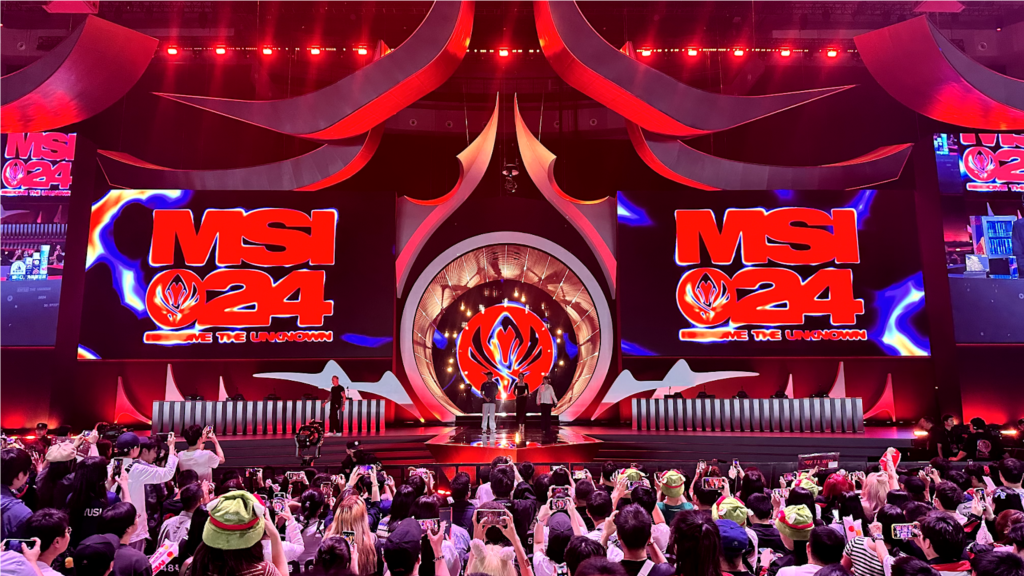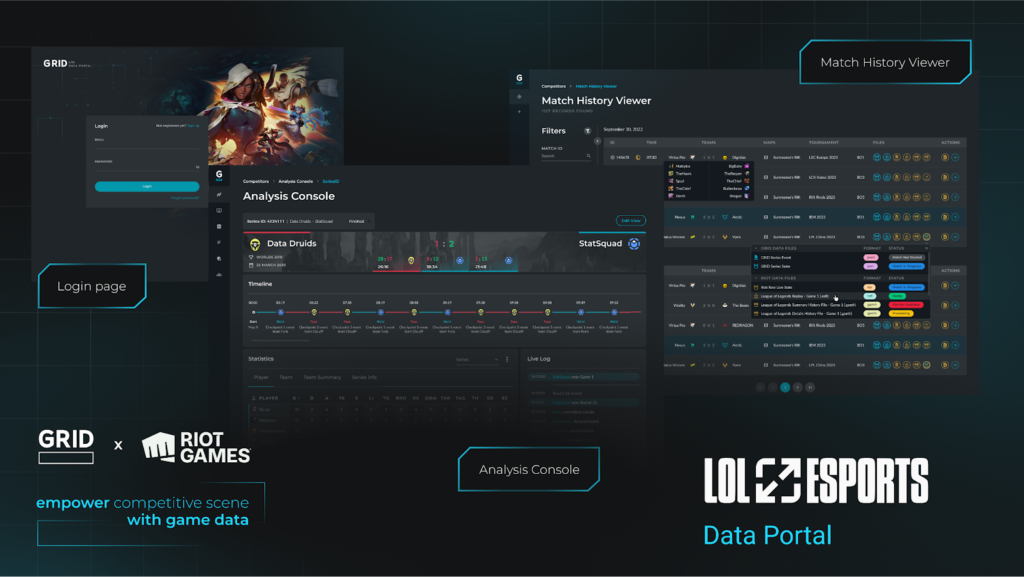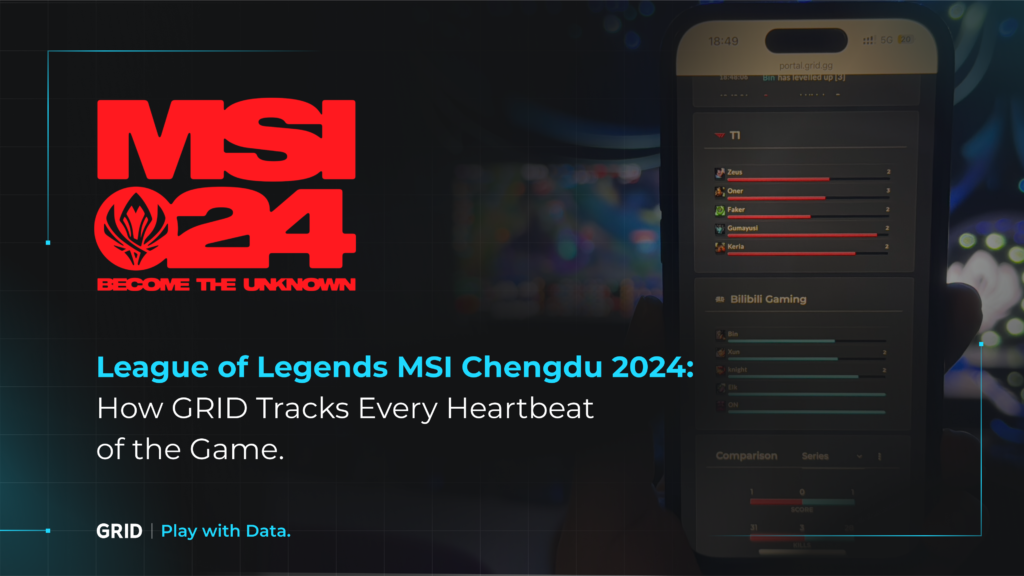The Mid-Season Invitational (MSI) is the second-largest event in the League of Legends esports calendar. MSI 2024 in Chengdu not only set a new all-time MSI peak viewership record when T1 defeated G2 in the semifinals, but it also marked the tournament’s first return to China since 2017.
This MSI was also the first international LoL esports tournament for which live data was available on the GRID Data Platform. Top-tier esports was on display with comebacks, upsets, denials and other incredible moments that international League competitions are known for. For example, Gen.G’s Kim “Peyz” Su-hwan set a new all-time international LoL tournament record with 28 total kills in a single game during the grand finals — the previous record was only 18.
With this level of action, even seasoned LoL connoisseurs, let alone newbies on the Rift, can have a hard time following every second of the game. GRID solves this problem by collecting all in-game data live (directly from the game) and distributing it in real-time to power data visualization, predictions and other products built by GRID’s customers: enhancing fans’ interactions with the fast-paced game.
In this article, we explain how esports live data is collected and distributed live using MSI Chengdu 2024 as an example.

MSI 2024 was the first international LoL Esports competition on the GRID.
GRID — the gateway to LoL Esports official live data.
Since 2018, GRID has been providing in-game data infrastructure and distribution solutions in a secure environment to rights holders. In 2022, we partnered with Riot Games to bring VALORANT Esports data to the GRID Data Platform.
GRID’s access to real-time LoL Esports data is the result of our exclusive partnership expansion, enabling us to support both VALORANT and League of Legends Esports. This partnership recognizes the importance of reliable and secure data handling in competitive gaming and upholds the integrity of esports by ensuring that live data distribution is controlled and protected against misuse.
Access to data is granted to trusted partners who can contribute to building a sustainable ecosystem.
Doug Watson, Director, Strategic Advisory, Esports at Riot Games, stated, “In our ongoing partnership with GRID, we have seen the significant impact that real-time, official data can have on the esports ecosystem. The integration of GRID’s technology allows us to provide access to various stakeholders to the most reliable and granular data, enhancing the experience for fans and players alike. At Riot Games, we are committed to maintaining the integrity of our competitive gaming events, and GRID’s expertise in data handling ensures that our esports data is secure and used to its fullest potential.”
If you are curious to find out more, check the dedicated Riot Esports Data site.

From the first pick to a final kill — it’s on the GRID.
Step 1: Data Sourcing
GRID works directly with game publishers to access the game infrastructure and collect data from an official source. This is the only way to officially access game data. Official access to data is crucial for a few reasons:
- In-game data is a part of game IP and should be treated with the utmost respect and care. This is only possible when partnering with the IP owner — the game publisher.
- Data that comes directly from the game is of superior quality. Granularity, speed, and security are guaranteed thanks to the alignment between us and the rights holders and access to the official data source.
- With licensed, secure data sourcing and distribution, we can ensure that the integrity of the game is preserved.
This process of data sourcing is complex. Detailed gameplay information must be captured without impacting game performance, so the technical integration must be made before the game starts. The GRID Data Platform automatically triggers data collection at the ‘pick-and-ban phase’, before the battle on the Rift even starts.
Live LoL Esports data collection on the GRID Data Platform.
GRID CTO Chris King explains: “It would not be possible to enable such a powerful data layer, without an efficient and robust approach to data collection. “GRID has developed extraction technology that enables reliable data collection at the game-infrastructure level, ensuring resilience to changes in the game, and the ability to capture the complex detail of a game such as League of Legends; — all with a minimal compute-resource footprint that ensures the underlying game is never affected by the collection of in-game data.” –
Because of GRID’s technology, data collection occurs seamlessly in real-time and is invisible to the players — maintaining the integrity and pace of gameplay, crucial for any event from seasonal playoffs to global competitions.
Step 2: Formatting Data Feeds
With the sourcing complete, live data must then be formatted to ensure uniformity across the various game titles that GRID’s clients have access to, including titles from different genres. In Riot Games’s example, both LoL and VALORANT.
These two game titles may appear vastly distinct from one another, but a closer examination of mechanics often reveals significant similarities in how they function as playable experiences.nThe GRID Data Platform is engineered with the ability to build out support for these common mechanisms, which can then be used to model any title in data.
This approach at GRID is called game title agnostic (learn more about The Game Title Agnostic Vision from GRID’s CTO). Modeling a title involves creating a data framework to identify which data points (or mechanisms) are important to track the progress of any given match.
To illustrate, here are some examples of mechanisms supported by GRID:
- Segments — a match can be split into multiple segments. For example, a match segment can be ‘won’ and all data collected during the segment can be labeled and correctly attributed.
- Objectives — players or teams can achieve important objectives in-game. Who has completed which objectives and how many times are all maintained.
- Clocks — time (and timing) is an important mechanism in many games. It’s used as the main game clock, ability cooldown timers, respawn countdowns or objective timers. Clocks can count up or down, be started, stopped or set.
These distinct common mechanisms are the building blocks used to model a game title and create a data feed for it. Each feed enables a certain set of behaviors that are displayed in the following forms.
- State — a complete overview of the current circumstance of an ongoing match.
- Commands — functionality that allows game developers to transmit detailed in-game happenings to the GRID Data Platform, informing how to alter the state. Each supported mechanism has a set of commands used to interact with it.
- Events — a set of supported events for each mechanism, detailing which specific action happened and how that action has altered the state over time (see here for further reading on state and events at GRID).
The title agnostic framework is invaluable for GRID’s clients, who require consistent data structures to develop applications or insights — all available with a single integration with the GRID Data Platform. This structure also benefits the data analytics efforts of esports teams by requiring only the understanding of a single format to leverage the capabilities of the various GRID Data Portals for each supported esports title.
Step 3: Data Distribution & Visualization
After data is collected and standardized, GRID distributes live data, fixtures service and audio/visual feeds to commercial clients and professional teams on behalf of Riot Games. This data can be accessed either in real-time via an API integration (commercial clients) or through the LoL Data Portal (professional esports teams). For access to live LoL esports data, contact the GRID team via this form.

GRID Data Visualization for League of Legends powered by live data at MSI Chengdu 2024.
Because of the title agnostic approach, a single commercial integration opens access to all titles available exclusively on the GRID, including Riot’s League of Legends and VALORANT live esports data, schedules, stats and visualizations.
Additionally, professional esports teams can access their historical match data via the League of Legends Data Portal.
To preserve match integrity, data is distributed to teams postgame. Teams can leverage the raw data feeds or use an analyst console to survey game snapshots. When not competing in tournaments, teams can also use the League of Legends Data Portal to scrim against each other in a secure, ring-fenced environment.

League of Legends Data Portal powered by GRID
Data powers the future of esports.
World-class tournaments like MSI Chengdu 2024 set the stage for breathtaking feats of LoL gameplay, exciting fans around the world and pushing the game to its limits. Due to the digital nature of esports and the right technology in place, every single heartbeat of these games can now be tracked.
It’s an incredible opportunity to quantify moments on the Rift, turn them into new ways of engagement and glean data-driven insights.
Whether it’s League of Legends or VALORANT, Riot Games and GRID’s global official data partnership will continue to bolster the esports community by supplying official data — the most reliable and granular real-time assets — to trusted partners, in a format that makes it easy to work with and unlocking its potential for everyone.
You can read more about the partnership with GRID at Riot’s Official Esports Data website.


